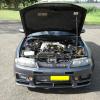Alot Of Oil In The Blow Off Plumbing?
Announcements
-
Similar Content
-
Latest Posts
-
I was more thinking so it doesn't flop around as much rather than for rotating it. Once you have the balance right, it should rotate well enough, depending on how much resistance there is on the pivot. I think you said the pivot point was on a bearing though didn't you?
-
You can get them with the worm drive rotator but I was too tight to pay another $250-$300 so manual labour it is! I don't think it will be too hard to rotate though.
-
Sag as in the windows start to slowly open themselves, or they're just slow to go up/down with engine off?
-
It looks like it needs a big worm gear drive on it to control the rotating, not a few sloppy pins!
-
As Duncan said, first there was OBD, which few cars used, then came OBD2. Now an interesting point, OBD2 isn't even for what you want to do. OBD2 is for emissions testing. There is some sensor data on OBD2, but it's up to the manufacturer what they're putting on it. Most scan tools operate on UDS, which like OBD2 is a standard built on-top of CAN. UDS specifies how to structure a message, what very limited things mean such as "read memory address" but it does not specify what is stored in which memory address, that is all up to the manufacturer. You either a scan tool compatible with that vehicle, or to know how to reverse engineer all the data, which can take a VERY long time and a lot of vehicles to get it right. Oh and then the manufacturer does a firmware update and changes what's where... Ask me how I know that as fact Oh, and by the time you've got the scan tool that supports all the manufacturers stuff, well, you're back at "But a consult cable and the Nissan software" The main difference being most manufacturers software these days works with the same hardware readers, as the readers are built to support J2534 which is another standard for how the PC communicates with the tool to make it do specific things on the car...
-







Recommended Posts
Create an account or sign in to comment
You need to be a member in order to leave a comment
Create an account
Sign up for a new account in our community. It's easy!
Register a new accountSign in
Already have an account? Sign in here.
Sign In Now